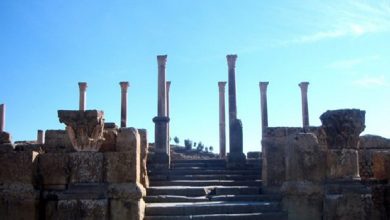Space tragedy of palaeolithic age: What destroyed ancient settlement of Abu Hureyra?

The ancient settlement of Abu Hureyra, which existed on the territory of modern Syria in the Paleolithic era, has long been known to archaeologists. However, after conducting a series of studies, scientists have understood the uniqueness of this village and can say with certainty that this is not just an archaeological site. Twelve thousand eight hundred years ago, the settlement and its inhabitants were destroyed by fragments of a comet.
Abu Hureyra is a settlement (commonly known as Tell) located in northern Syria along the Euphrates River. A large mound leftover from an ancient village now rests at the bottom of Lake Assad.
Back in 1972 and 1973, excavations of bottom sediments were carried out on the southwestern coast of the Euphrates floodplain. Half a century later, the research continued and brought startling conclusions: red-hot fragments of a celestial body (most likely a comet) fell on the village.
Archaeologists, one of whom was previously on the same team that studied the village in the 1970s, recently published their findings in several foreign publications. Andrew Moore, a co-author of the article and a member of the Abu Hureyra excavation team, said that soil samples from the original excavation site helped to establish the cause of the village’s death.
What scientists discovered half a century later
Even after excavations in the 1970s, Moore noticed burnt areas, but scientists did not associate this with a cosmic phenomenon.
Modern studies of the burnt samples showed that the entire area was destroyed by the fire that arose as a result of the explosions of the decaying comet. Most of the air explosions did not have contact with the Earth; however, in the case of the village of Abu Hureyra, this happened, as evidenced by molten glass and sand, which also melted and quickly solidified. The town, according to scientists, was destroyed in the blink of an eye.
High concentrations of particles of iridium, platinum, nickel and cobalt suggest mixing local molten sediment with a small amount of meteorite material. The researchers explain that the low water content in molten glass is consistent with tektite formation and is not consistent with volcanism and anthropogenesis.

In Abu Hureyra, a large amount of molten glass (so-called AH glass) has been examined, and high-temperature minerals have been identified, such as corundum (melting point approx. 2044°C), mullite (1840°C) and cerussite (2300°C). The latter mineral is scarce on Earth but is often found in meteorites, which suggests its cosmic origin.
“The study of molten minerals suggests that the village was destroyed by an air explosion or the impact of a cosmic body,” explains Moore.
Moore explained that all other possible causes of fire in Abu Hureyra have been studied and eliminated scientifically.
“Neither ordinary fires, nor even volcanic ash can reach such a temperature that could suddenly raze the village to the ground, leaving behind evidence of this kind in the soil,” scientists say.
To make it more transparent what temperatures are in question, one of the authors of the study, professor of geology at the University of California at Santa Barbara, James Kennett, explains:
Such high temperatures would completely melt an ordinary car in less than a minute. This intensity could only be caused by an extremely powerful, high-energy, high-speed phenomenon – something like a cosmic impact.
The scientists concluded that AH glass was formed by fires in thatched huts at temperatures around 1200°C through heating experiments. One can only guess how terrible the death of the people who were in the settlement was.
How the comet influenced the life of ancient people
A large body of evidence supports the hypothesis that a “cosmic event” occurred in Abu Hureyra about 12,800 years ago, simultaneously with similar impacts that were struck at other objects on four continents. For example, similar shards of glass of about the same age have been found in Melrose, Pennsylvania, Blackville, and South Carolina (USA). The most distant site containing high-temperature molten artefacts is in Pilauco, Chile.
It was during this period, according to scientists, that a celestial body collided with the atmosphere of our planet, after which numerous smaller fragments could hit the Earth, forming transient surface craters. This event triggered a cascade of spillovers, including short-term cooling and severe climate change, which could also contribute to the extinction of a large number of animal species and population decline.

Scientists Moore and Kennett concluded that climate change caused by the impact of the comet led the prehistoric inhabitants of the Middle East to switch from hunting and gathering to agriculture. And this, in turn, testifies to the earliest agriculture – one of the most significant cultural transformations in the history of humanity.
From all of the above, scientists make another important conclusion: the impact of comet fragments, causing a change in climate and fauna, unwittingly led to significant progress in agriculture and its economic benefits. Such is the legacy left to the Earth by a comet that fell on a Paleolithic village.




